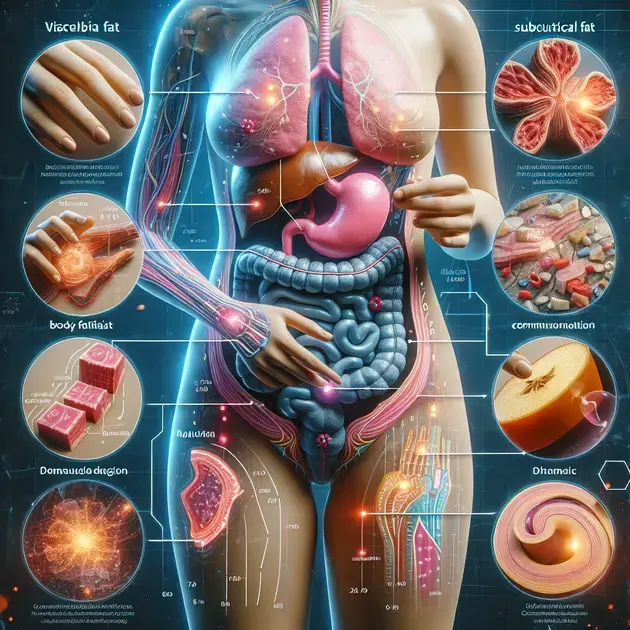When it comes to health and wellness, understanding body fat is crucial for making informed decisions about our lifestyle. In this comprehensive guide, we will delve into the various aspects of body fat, including its types, functions, and impact on overall health.
Recent studies have shown that the distribution of body fat can be a more important indicator of health risks than the total amount of body fat. By gaining a better understanding of body fat and its implications, we can take proactive steps towards achieving a healthier and more balanced lifestyle.

**Types of Body Fat and Their Functions**
Subcutaneous Fat
Subcutaneous fat is the type of fat that is found directly under the skin. It serves as a layer of insulation to help regulate body temperature and protect organs. One way to measure subcutaneous fat is through skinfold calipers, which can be easily purchased online or at fitness stores. Apps like MyFitnessPal offer guidance on how to track changes in subcutaneous fat percentage over time.
Visceral Fat
Visceral fat is located deep within the abdominal cavity and surrounds vital organs such as the liver, pancreas, and intestines. This type of fat is associated with increased health risks, including heart disease and type 2 diabetes. To monitor visceral fat levels, devices like smart scales with bioelectrical impedance analysis (BIA) technology, such as the Fitbit Aria, can provide insights into overall body composition.
Brown Fat
Brown fat is a specialized type of fat that generates heat by burning calories. It plays a role in regulating body temperature and metabolism. To activate brown fat, one can expose themselves to cold temperatures or engage in activities that stimulate thermogenesis. The Cold Exposure App offers tips on incorporating cold exposure therapy into daily routines.
White Fat
White fat is the most abundant type of fat in the body and serves as an energy storage depot. It also secretes hormones that regulate appetite, metabolism, and immune function. To manage white fat levels, apps like Lose It! provide personalized weight loss plans and nutritional guidance to support a healthy balance of white fat in the body.
Beige Fat
Beige fat is a transitional type of fat that can convert stored energy into heat, similar to brown fat. It is found in small deposits scattered throughout white fat tissue. To enhance the activation of beige fat, individuals can incorporate high-intensity interval training (HIIT) workouts into their exercise routines. Apps like Nike Training Club offer HIIT workouts tailored to individual fitness levels.
**Health Risks Associated with Body Fat Distribution**
Apple-Shaped vs. Pear-Shaped Body Fat Distribution
Individuals with an apple-shaped body fat distribution tend to carry excess fat around their abdomen, which is associated with a higher risk of developing cardiovascular diseases, stroke, and metabolic syndrome. On the other hand, pear-shaped body fat distribution, where fat is predominantly stored in the hips, thighs, and buttocks, is considered less harmful to health.
Metabolic Syndrome
Metabolic syndrome is a cluster of conditions, including high blood pressure, high blood sugar, abnormal cholesterol levels, and excess abdominal fat. It significantly increases the risk of heart disease, stroke, and type 2 diabetes. Monitoring blood pressure and blood sugar levels using apps like Blood Pressure Tracker & Checker can help individuals manage the health risks associated with metabolic syndrome.
Insulin Resistance
Excess fat, especially visceral fat, can lead to insulin resistance, where cells fail to respond effectively to insulin. This condition is a precursor to type 2 diabetes and can result in elevated blood sugar levels. Apps like Glucose Buddy provide tools for tracking blood glucose readings, medication intake, and physical activity to assist individuals in managing insulin resistance.
Cardiovascular Disease
Excessive body fat, particularly around the abdomen, is a major risk factor for cardiovascular disease. It can contribute to the buildup of plaque in the arteries, leading to atherosclerosis and increased heart attack and stroke risk. Apps like MyFitnessPal offer support in setting cardiovascular exercise goals and tracking progress to improve heart health.
Inflammatory Responses
Adipose tissue secretes inflammatory substances that can trigger chronic low-grade inflammation in the body. This systemic inflammation is linked to various health conditions, including arthritis, cancer, and autoimmune disorders. Lifestyle changes, such as following an anti-inflammatory diet recommended by apps like The Anti-Inflammatory Diet & Meal Prep, can help reduce the inflammatory effects of excess body fat.
Overall Mortality Risk
The distribution of body fat, along with the overall amount of body fat, influences the risk of premature mortality. Individuals with central obesity, characterized by excess belly fat, face a higher likelihood of premature death compared to those with a lower waist-to-hip ratio. Monitoring body composition changes with apps like BodyBarista can provide insights into health improvements and potentially decrease overall mortality risk.

**What Is Body Fat and Why Is It Important**
Understanding Body Fat
Body fat is an essential component of our bodies that serves various important functions. It acts as a source of energy, cushions and protects our organs, and helps regulate our body temperature. Body fat also plays a crucial role in hormone regulation and overall metabolism. There are different types of body fat, including subcutaneous fat that lies just beneath the skin and visceral fat that surrounds our organs.
Having an appropriate level of body fat is important for overall health and well-being. Too much body fat can increase the risk of various health issues such as heart disease, diabetes, and high blood pressure. On the other hand, having too little body fat can also be detrimental to health, leading to hormonal imbalances and decreased immune function.
It is important to note that body fat percentage is a more accurate indicator of health than simply looking at body weight. For example, a person may have a high muscle mass, which can increase their weight on the scale, but may still have a low body fat percentage and be in good health.
Overall, understanding body fat and its importance in maintaining a healthy body composition is key to promoting optimal health and well-being.
Importance of Managing Body Fat Levels
Maintaining healthy body fat levels is crucial for overall health and well-being. Excess body fat, especially visceral fat, has been linked to a higher risk of chronic diseases such as type 2 diabetes, heart disease, and certain types of cancer. Managing body fat levels through proper nutrition, regular exercise, and lifestyle choices can help reduce these risks and improve overall health.
One effective way to manage body fat levels is through a combination of a balanced diet and regular physical activity. Eating a diet rich in whole foods, such as fruits, vegetables, lean proteins, and whole grains, can help support weight management and reduce body fat levels. In addition, engaging in regular exercise, including both cardio and strength training, can help burn excess calories and promote fat loss.
It is also important to pay attention to lifestyle factors that can impact body fat levels, such as sleep quality, stress management, and hydration. Adequate sleep, stress reduction techniques, and staying hydrated can all contribute to a healthy body composition and overall well-being.
By actively managing body fat levels through a combination of healthy eating, regular exercise, and lifestyle choices, individuals can improve their health outcomes and reduce the risk of chronic diseases associated with excess body fat.
Genetics and Body Fat Distribution
Genetics play a significant role in determining how body fat is distributed throughout the body. Some individuals are genetically predisposed to store more fat in certain areas, such as the abdomen or hips, which can impact overall body composition and health. While genetics can influence where fat is stored, lifestyle factors such as diet and exercise also play a crucial role in managing body fat distribution.
Understanding the role of genetics in body fat distribution can help individuals tailor their approach to weight management and overall health. By knowing their genetic predispositions, individuals can make informed decisions about their diet, exercise routine, and lifestyle habits to optimize their body composition and reduce the risk of health issues associated with specific fat distribution patterns.
While genetics may influence where fat is stored, it is important to remember that lifestyle choices still have a significant impact on overall body fat levels and health outcomes. By combining genetic knowledge with healthy habits such as regular exercise, balanced nutrition, and stress management, individuals can work towards achieving a healthy body fat distribution and promoting optimal health.
In conclusion, genetics play a part in body fat distribution, but with the right approach to lifestyle choices, individuals can effectively manage their body fat levels and promote long-term health and well-being.
**
Conclusion
**
Understanding the importance of body fat in our bodies is essential for overall health and well-being. Body fat serves crucial functions such as providing energy, protecting organs, and regulating body temperature. It is vital to maintain an appropriate level of body fat to prevent health issues like heart disease and diabetes while also avoiding the negative impacts of having too little body fat.
Managing body fat levels through a balanced diet, regular exercise, and healthy lifestyle choices is key to reducing the risk of chronic diseases associated with excess body fat, particularly visceral fat. Incorporating whole foods like fruits, vegetables, and lean proteins while engaging in both cardio and strength training can promote weight management and fat loss.
Genetics play a role in body fat distribution, but lifestyle factors such as diet and exercise also influence where fat is stored. By understanding genetic predispositions and making informed choices around nutrition, physical activity, and stress management, individuals can optimize their body composition and reduce health risks related to specific fat distribution patterns. Combining genetic knowledge with healthy habits can lead to a balanced body fat distribution and improved overall health outcomes in the long term.